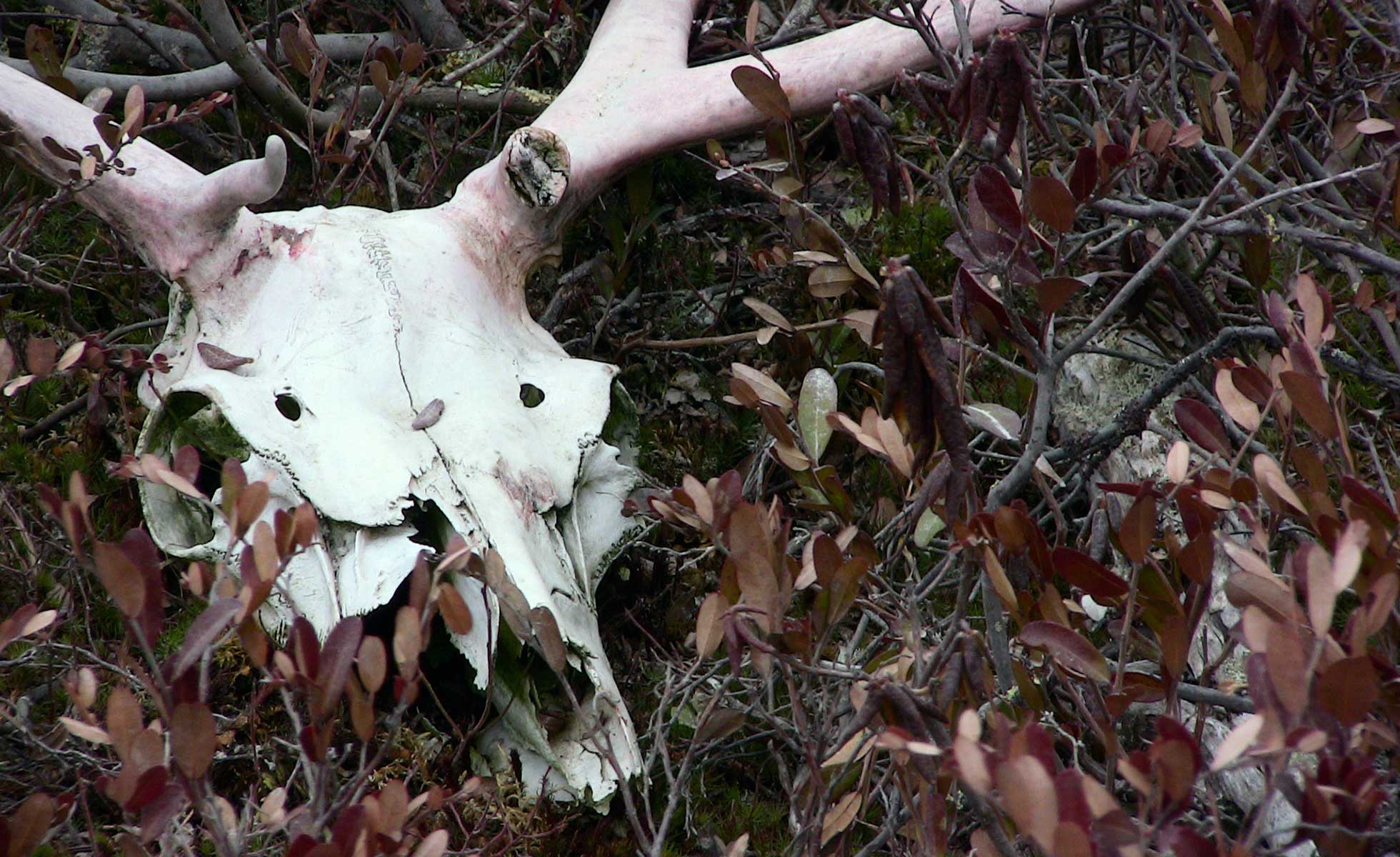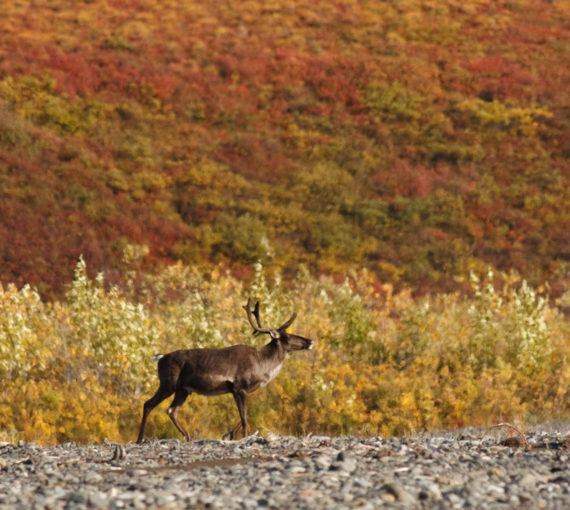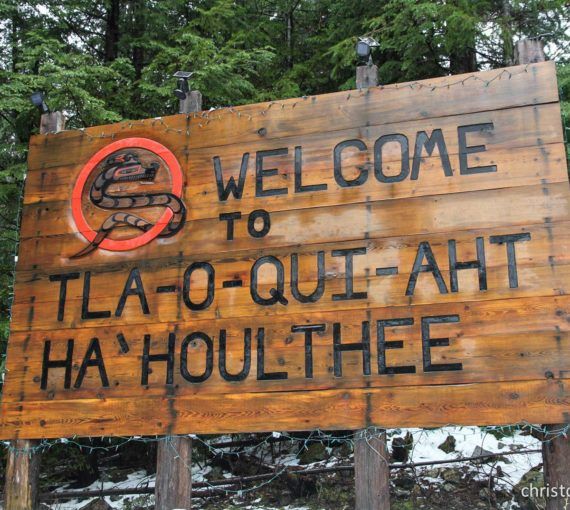
Caribou skulls and antlers are traditionally hung from trees as a sign of respect for the animal. (Photo: peupleloup via Flickr)
Kuei! Menissa nitishinikashun. Ekuanitshit nutshin.
Innuishkueu au nin.
Kuei! My name is Melissa. I am from Ekuanitshit.
I am an Innu woman.
I recently joined the David Suzuki Foundation as boreal campaigner, with caribou conservation in mind. As such, I am bringing not only what I have learned in schools but teachings that have been passed down by our own knowledge-keepers. These have proven to be the future of conservation practices, illustrating what humans need to keep being a part of this cycle of relations that have kept us thriving in some of the hardest places on Earth for millennia. This knowledge has been shared from nation to nation through our storytelling and is not bound by a book cover, but by the relations that bind these stories to their territories. These stories are the encyclopedia of the land.
At the beginning, when only water covered the earth, Kuekuatsheu, the wolverine, embarked on a raft with all the animals. They descended to Earth together. Once on the water, he sent out Otter, Beaver and Muskrat to find some earth. The first two could only go so far but Muskrat made the trip back up, with a fistful of dirt. This exploit would have cost him his life, but thanks to his sacrifice, Kuekuatsheu spread and multiplied the land in Muskrat’s hand with the power of his breath. Since that day we hold a special respect for Muskrat. As Innuat, the relationship we hold with animals is one of great respect. Some jokingly remind us that we tend to eat those we “respect”. Perhaps this respect for the animals we eat demonstrates how we truly value them.
This knowledge has been shared from nation to nation through our storytelling and is not bound by a book cover, but by the relations that bind these stories to their territories. These stories are the encyclopedia of the land.
One version of this story tells us that when Kuekuatsheu wanted to get off the raft and walk on land, Caribou jumped over his head and was the first to touch ground. The wolverine, being a proud and selfish trickster, told Caribou, “You will never build a house and will always roam the vast land.” It’s true that caribou have since been all across our territories and have been a staple of survival for so many nations I can’t name them all here. Their territory is vast. Out of all the animals needing conservation and protection, they need the largest area. In its recovery strategy, Canada acknowledges that the woodland caribou needs a minimum of 65 per cent undisturbed habitat in a range as the disturbance management threshold, which provides a measurable probability (60 per cent) that a local population will be self-sustaining. Kuekuatsheu’s declaration recognizes the actual needs of the caribou: lots of land for its huge herds.
One being I can name is Papakassik, the caribou master. He is the one we pray to when we want to be “lucky” at hunting. He will decide if we are worthy or not of getting one of his children. We used many ways to communicate with him, through drumming the “Teuaikan,” with the shaking tent and by never wasting any of the caribou. The relation we have to uphold with Papakassik through our treatment of his most precious gift was central. But in one aspect, Kuekuatsheu was wrong. Caribou do have a house, one in which they hide from humans when the relationship ceases to be balanced.
Why is this relationship so strong? Maybe it stems from the fact that Papakassik was an Innu man in the beginning, and even though he joined the caribou nation he still had a thought for his first family. Or maybe it can be summed up with the fact that this relation gave us the capacity to survive and thrive on our territories — territories judged poor farming lands. My own territory was called ‘’Cain’s land’’ by the first European settlers, named for the place where Cain was banished to after he had murdered his brother. But our lands are rich and we have been here since time immemorial, not needing to colonize other lands for resources. That survival rests on these relations we built and continue to uphold. As caribou herds diminish and they retreat to their spiritual house, it might be time we asked non-Indigenous people to acknowledge their part in the relationship and see it as a tool of survival for their own children as much as ours. With the ongoing climate change catastrophe, coming years might see a rise of Canadian inland biodiversity refugees having to leave their ancestral lands due to loss of sustainability. There is only so much a $75 watermelon can do to feed a northern community.
Far away in Mushuau sipi, that’s where caribou lives. There is caribou habitat where people can’t go. If someone goes there, then it fogs to hide the caribou. There are mountains that surround caribou habitat; if people went there, they wouldn’t see the caribou. Caribou has a very strong leader who knows where to hide.
Philip Einish Sr., Naskapi Nation of Kawawachikamach, in A Long Time Ago in the Future: Caribou and the People of Ungava
Mitákuye Oyás’iŋ (all are related) is a phrase from the Lakota language that is often used to talk about unity, oneness, all my relatives, we are all related or all my relations. It’s often, in the English language, resonant of a hippie or love child vibe. The closest I could think of as a concept in Innu-aimun, my own language, would be “mamu” or “all together”. It would be hard to translate from language to language without leaving something of the culture behind.
Add to that translation from Lakota to English to Innu: three diverse nations with three diverse ways of expressing concepts. When we say “our lands” in English, it often represents a position of possession. In Indigenous concepts, it’s more about the relation or responsibility we have toward it. English is a language of things and names, while Indigenous languages tend to be action- and verb-related. The way I presented myself in the beginning was not boasting titles but informing readers to whom I was related and mostly to whom I have to answer and be responsible for the well-being of.
I asked my godmother, Yvette Mollen, an Innu-aimun expert, how we could express that concept in our own language:
“Kassinu auenitshenat tiapishiniht anite etauak — All those who are tied to where I am.”
So to all my relations, I hope we can be tied by an ancient understanding to the land, not one that language explains only as resources and things, but one of actions and relations tied to where we are. I hope this new journey in collaboration with the David Suzuki Foundation, by supporting Indigenous governance of lands, by honouring Indigenous responsibilities to ancestors and relations such as caribou, will help us teach and pass on this knowledge and these stories to all who need them.
Read our report profiling Indigenous-led governance of lands and waters


